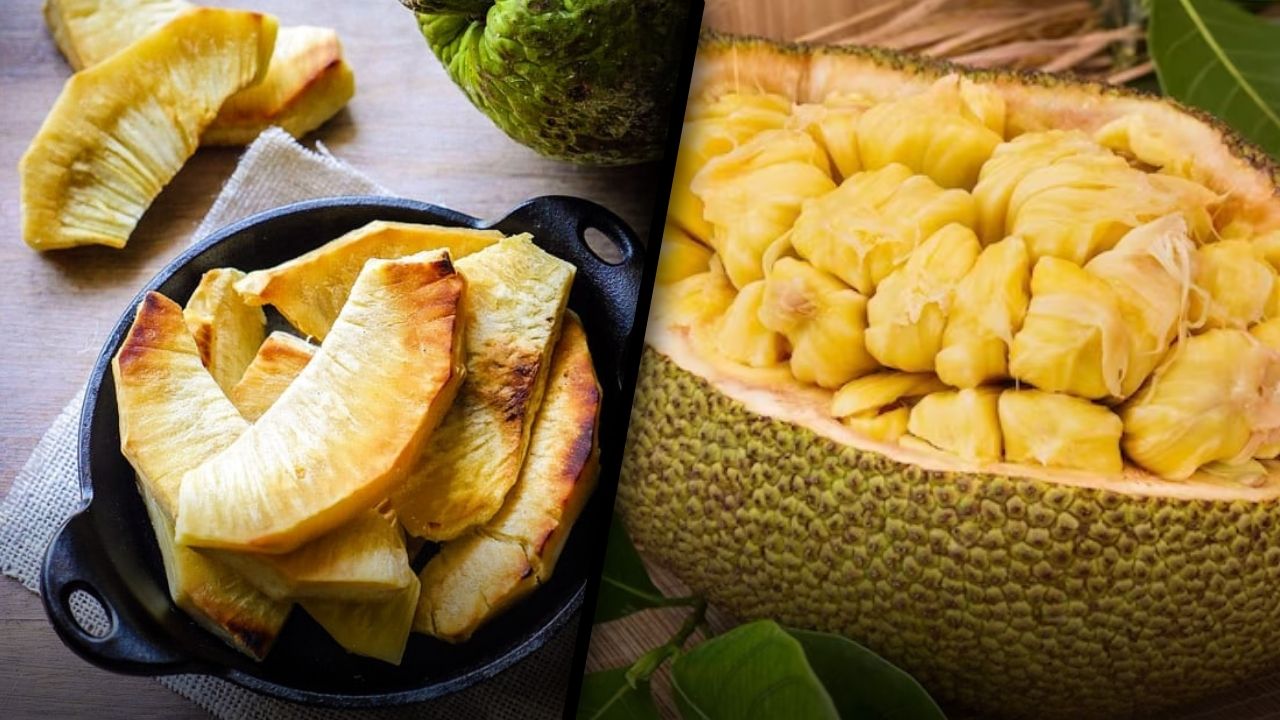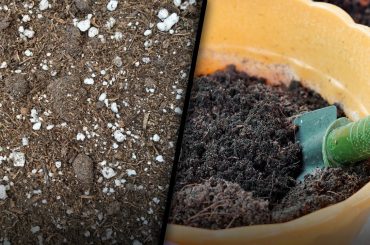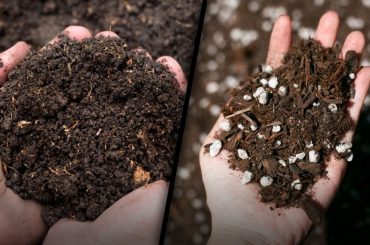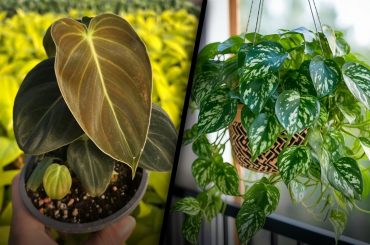Healthy carbs are abundant in breadfruit and jackfruit, tropical fruits. Among the many uses for these tropical fruits are savory and sweet dishes. They grow on trees and are packed with nutrients.
Find out what tropical trees are classified by, their characteristics, how they grow best, what they can do for our health, and how they are used in cooking.
Breadfruit vs. Jackfruit: Plant Classification:
Artocarpus is the genus of plants which includes breadfruit and jackfruit. A tropical tree, mulberry, also belongs to the same family as jackfruit and readfruit. In Southeast Asia and the Pacific Islands, Artocarpus contains about 60 species of tropical trees and shrubs.
They are, however, distinct species of tropical trees. Artocarpus altilis is the botanical name of the breadfruit tree, while Artocarpus heterophyllus is the name of the jackfruit tree.
Breadfruit vs. Jackfruit: Plant Characteristics
There are quite a few similarities between breadfruit and jackfruit physically. Each tree grows at least 40 feet tall, has glossy, dark green leaves with prominent veins, smooth brown trunks, and showy five-petaled leaves. It boils down to their leaf shapes and sizes, as well as the shapes of their fruit, that distinguish these two tropical trees.
Almost all of the leaves of breadfruit are pinnately lobed, with lobes extending outward from the central axis. These lobes can be found in any number between three and eleven on a breadfruit leaf. Moreover, breadfruit trees can grow leaves up to three feet long, distinguishing them from their smaller jackfruit cousins by their size.
A jackfruit leaf has a smooth margin and is elliptical in shape. Breadfruit leaves are much more visually appealing than jackfruit leaves, which can grow up to 12 inches long at maturity.
Their fruits are both large, fleshy, bumpy on the exterior, with an abundance of flesh. While breadfruit trees produce rounder fruit, jackfruit trees produce larger, oblong fruit. A jackfruit tree typically produces fruit weighing over 55 pounds, which makes it the world’s heaviest fruit! While breadfruit fruit typically reach 13 pounds, jackfruit fruits can reach over 55 pounds!
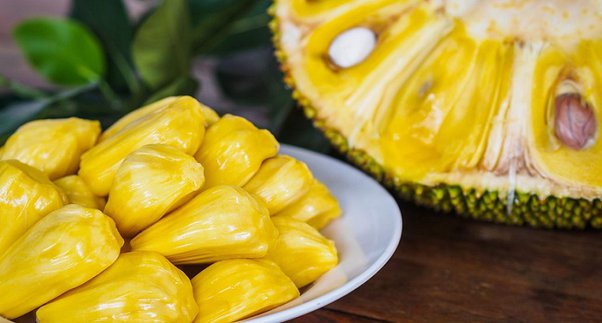
Breadfruit vs. Jackfruit: Native Ranges
There is a difference between the seedless breadfruit tree and the domesticated breadfruit tree because the latter is in fact descended from the wild breadnut tree, Artocarpus camansi. Domesticated breadfruits have a native range that extends from Papua New Guinea, Indonesia, and the Philippines because of the breadnut tree.
Traveling Pacific islanders brought breadfruit trees to Southeast Asia and the islands.
Additionally, tropical regions around the world cultivate jackfruit trees, which are native to Southeast Asia.
Breadfruit vs. Jackfruit:Ideal Growing Conditions
The jackfruit tree is sensitive to both drought and overwatering, while neither plant prefers a particularly damp climate. However, both plants prefer warm, humid climates. Poorly draining soil is not conducive to the growth of the jackfruit tree.
Colder climates will not support these tropical plants. USDA hardiness zones 10-12 are appropriate for jackfruit trees, while USDA hardiness zones 9a-11 are appropriate for breadfruit trees.
Culinary Uses and Nutritional Facts
Breadfruit
Potatoes and other starchy vegetables are similar to breadfruit in the kitchen. When cooked, breadfruit taste similar to freshly baked bread. It has a slightly sweet, starchy taste similar to plantain. There is no doubt that breadfruit is a staple ingredient for many people in Southeast Asia and the Pacific Islands; it’s often used in soups, stews, curries, casseroles, bakes, pancakes, and fritters.
Breadfruit vs. Jackfruit: Native Ranges
There is a difference between the seedless breadfruit tree and the domesticated breadfruit tree because the latter is in fact descended from the wild breadnut tree, Artocarpus camansi. Domesticated breadfruits have a native range that extends from Papua New Guinea, Indonesia, and the Philippines because of the breadnut tree.
Traveling Pacific islanders brought breadfruit trees to Southeast Asia and the islands.
Additionally, tropical regions around the world cultivate jackfruit trees, which are native to Southeast Asia.
Breadfruit vs. Jackfruit:Ideal Growing Conditions
The jackfruit tree is sensitive to both drought and overwatering, while neither plant prefers a particularly damp climate. However, both plants prefer warm, humid climates. Poorly draining soil is not conducive to the growth of the jackfruit tree.
In colder climates, neither of these trees will survive. Among the USDA hardiness zones for jackfruit trees, Zone 10-12 is the most suitable, while Zone 9a-11 is the best for breadfruit trees.
Culinary Uses and Nutritional Facts
Breadfruit
Potatoes and other starchy vegetables are similar to breadfruit in the kitchen. When cooked, breadfruit taste similar to freshly baked bread. It has a slightly sweet, starchy taste similar to plantain. It is also used in soups, stews, curries, casseroles, bakes, pancakes, and fritters among the people of Southeast Asia and the Pacific Islands.
As well as providing healthy sources of vitamins B6, B1, and C, Jackfruit also contains carbohydrates, potassium, and vitamin C. Vitamin B6, vitamin B1, vitamin C, potassium, and total carbohydrates are all present in a serving of jackfruit, which contains 32% of the daily recommended amount.
Jackfruit
When cooked correctly and using the right part of the fruit, jackfruit can either be used as a sweet food or a meat substitute. An interesting fact about jackfruit is that it has several different edible parts, each with its own distinct flavor. Its yellow pods are fleshy, sweet like mangoes or bananas, and surround the seeds. Sweet rice dishes, shaved ice, custards, and cakes are often made with this part of the jackfruit, which has a sweet flavor. White, fibrous flesh surrounded by yellow pods is another edible part of the jackfruit. Recipes using this part of the fruit often substitute meat for this part. In a vegan barbecue pulled pork recipe, jackfruit’s fibrous meat is widely used as a substitute for pork.
As well as providing vitamin B6, vitamin B1, vitamin C, potassium, and carbohydrates, Jackfruit is an excellent source of vitamin B6 and vitamin B1. The daily recommended amounts of vitamin B6, B1, vitamin C, potassium, and total carbohydrates are all found in jackfruit. A serving of jackfruit contains 32% of vitamin B6, 14% of B1, 25% of vitamin C, and 16% of potassium.
Tropical fruits like breadfruit and jackfruit are rich in nutrients and among the most common ingredients in worldwide kitchens.

